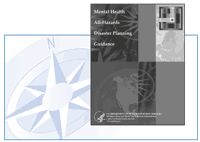 Disaster Preparedness: Disaster Preparedness:
Manual Provides Guidance
SAMHSA's Center for Mental Health Services recently contracted with the National
Association for State Mental Health Program Directors to create
a new resource manual for state and local mental health and substance
abuse authorities: Mental Health All-Hazards Disaster Planning
Guidance.
 Written
primarily by Brian W. Flynn, Ed.D., Associate Director of the Center
for Studies of Traumatic Stress, Uniformed Services University of
the Health Sciences, the guide is targeted to states and outlines
the necessary components of all successful disaster plans as well
as hazard-specific details. Written
primarily by Brian W. Flynn, Ed.D., Associate Director of the Center
for Studies of Traumatic Stress, Uniformed Services University of
the Health Sciences, the guide is targeted to states and outlines
the necessary components of all successful disaster plans as well
as hazard-specific details.
"The principle of all-hazards planning is that successful plans,
regardless of the disaster, include the same core elements," said
Dr. Flynn. "We've gathered all these elements into one comprehensive
document."
The manual is structured as a companion document to the Guide
for All-Hazards Emergency Operations Planning, published in
1996 by the Federal Emergency Management Agency (FEMA). The mental
health manual mirrors the language and format of the FEMA guide
to help planners integrate mental health and substance abuse activities
into overall emergency response operations.
Back to Top
Pre-Planning
As state authorities begin planning or improving an existing plan,
they are encouraged to review emergency plans from other states
for relevant information. Forging relationships with partners before
an event is vital, especially with the state's emergency management
agency. This agency's planning documents may already contain solutions
to common problems.
State authorities should also identify:
- A leader for plan formulation
- Benefits to potential partners as incentives to participate
- Planning office's legal obligations.
From the outset, the planning team must involve local mental health
and substance abuse partners. Planners should also include willing
participants beyond the typical circle of stakeholders, such as
interfaith groups, school systems, and organizations serving special
populations such as children or older adults.
Back to Top
Plan Components
All successful disaster plans include several common elements-that's
the driving principle behind the all-hazards approach. A good introduction,
for instance, will clearly outline a plan's purpose and describe
the most likely scenarios and vulnerable populations/facilities
in a given area.
Similarly, a "Concept of Operations" component will define what
should happen, when, and who should direct, the division of responsibility
(state, local, Federal); and who can request aid and in what situations.
Plans will organize and assign responsibilities by listing team
tasks and responsible parties, and describing tasks for anyone outside
the core group.
An administration/logistics/legal section will plan for recording
program activities, expenditures, and human resource utilization;
support needs (food, water, shelter, etc.) and equipment maintenance;
and legal issues (jurisdictions, liability, emergency waiver of
procurement rules, etc.).
The ideal plan will also feature a glossary, communication methods,
public information strategies, and procedures for mobilizing staff
and services.
Back to Top
Hazard-Specific Planning
With core elements in place, state plans can address specific events-from
natural disasters to community violence. These sections should identify
high-risk areas and the unique aspects of each hazard. For example,
during a hurricane, long-standing floodwaters in low-lying areas
may delay repair to homes. These delays can displace victims for
long periods of time and cause additional individual and family
stress.
Terrorism preparedness, which deserves its own section, must address
myriad details, including identification of potential targets; an
understanding of potential hazards including biological, chemical,
nuclear/ radiological, explosive, cyber, or a combination; and situational
considerations such as climate, geography, urban/rural status, and
transport patterns.
With checklists, a wealth of resources, and sample forms, Mental
Health All-Hazards Disaster Planning Guidance is an invaluable
tool for state and local mental health and substance abuse administrators
who must be prepared for anything.
Other publications available on related topics are described in
Disaster Preparedness: Publications.
To obtain copies of the publication, contact SAMHSA's National
Mental Health Information Center at P.O. Box 42490, Washington,
DC 20015. Telephone: 1 (800) 789-2647 or 1 (866) 889-2647 (TTY).
Or, visit www.samhsa.gov. 
« See Also—Previous
Article
See Also Related
Material—Publications »
See Also—Next Article »
Back to Top
|




